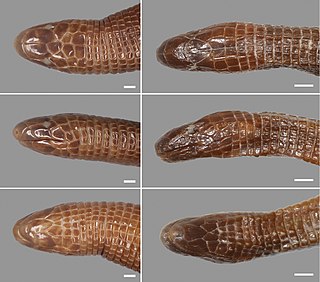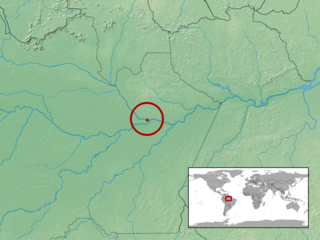
The Amphisbaenidae are a family of amphisbaenians, a group of limbless vertebrates.

Amphisbaena is a genus in the family Amphisbaenidae, commonly known as worm lizards. Over 100 species are placed in this diverse genus.

Amphisbaena alba, also known as the red worm lizard or less commonly as the white or white-bellied worm lizard, is a species of amphisbaenian in the reptilian order Squamata. Despite the large geographic range that this species covers, little is known about its ecology due to its secretive habits. A. alba has a diverse diet ranging from plant material to small vertebrates. Numerically, beetles, ants, and spiders compose the majority of their diet; however, ants, insect larvae, beetles, cockroaches, hemipterans, mole crickets, crickets, grasshoppers, termites, spiders, scorpions, pseudoscorpions, and annelids are ingested to satisfy a larger volume. The females are somewhat larger than the males, and can reach over 80 cm, which is quite large for an amphisbaenian. They are known to bury themselves in leafcutter ant nests and hide in the ants’ garbage dump areas to avoid irritating the ants into attacking, and to bury themselves to avoid predation in general.

Darwin's ringed worm lizard is a species of amphisbaenian in the family Amphisbaenidae, endemic to South America.
The Carvalho worm lizard, also known commonly as Carvalho's worm lizard, is a species of worm lizard in the family Amphisbaenidae. The species is endemic to Brazil.
Heath's worm lizard is a species of amphisbaenian in the family Amphisbaenidae. The species is endemic to Brazil, in the state of Rio Grande do Norte.
Silvestri's worm lizard is a species of worm lizard in the family Amphisbaenidae. The species is endemic to South America.
Vanzolini's worm lizard is a species of amphisbaenian in the family Amphisbaenidae. The species is native to northern South America.
Amphisbaena carli is a species of amphisbaenian in the family Amphisbaenidae. The species is endemic to Brazil.
Amphisbaena cunhai is a species of amphisbaenian in the family Amphisbaenidae. The species is endemic to Brazil.
Hoge's worm lizard is a species of amphisbaenian in the family Amphisbaenidae. The species is endemic to Brazil.
Amphisbaena hoogmoedi is a species of worm lizard in the family Amphisbaenidae. The species is endemic to Brazil.
The Urucum worm lizard is a species of worm lizard in the family Amphisbaenidae. The species is endemic to central South America.

The Rio Grande worm lizard is a species of worm lizard in the family Amphisbaenidae. The species is endemic to Brazil.
Roze's worm lizard is a species of amphisbaenian in the family Amphisbaenidae. The species is endemic to Venezuela.
Amphisbaena sanctaeritae is a species of amphisbaenian in the family Amphisbaenidae. The species is endemic to Brazil.

Slater's worm lizard is a species of amphisbaenian in the family Amphisbaenidae. The species is endemic to western South America.

Slevin's worm lizard is a species of amphisbaenian in the family Amphisbaenidae. The species is endemic to northern South America.
Mesobaena rhachicephala is a species of amphisbaenian in the family Amphisbaenidae. The species is native to Brazil.
Amphisbaena mebengokre is a species of worm lizard in the family Amphisbaenidae. The species is endemic to Brazil.




